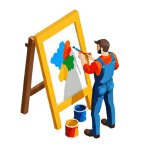Welcome to the How to Paint Online Lesson for Painters!
Introduction: Painting Safety
Before we dive into the world of painting techniques and tips, it is crucial to prioritize painting safety. Whether you are a beginner or an experienced painter, ensuring a safe painting environment is essential for your well-being and the quality of your work.
In this lesson, we will cover the importance of using the right protective gear, proper ventilation, handling chemicals and materials safely, and maintaining a clean workspace. By following these safety guidelines, you can enhance your painting experience and create beautiful works of art with peace of mind.
Let's get started on our journey to becoming safe and skilled painters!
Creating a safe environment is essential when it comes to painting. By following these guidelines, you can ensure that your painting experience is not only enjoyable but also free from accidents or injuries:
1. Ventilation: Always ensure that the area where you are painting is well-ventilated. Open windows and doors to allow fresh air to circulate and prevent the build-up of fumes from paint and solvents.
2. Lighting: Proper lighting is crucial for accuracy and safety while painting. Make sure you have sufficient lighting to see your work clearly and avoid straining your eyes.
3. Tripping hazards: Keep your painting area free from clutter and obstacles that could cause you to trip and fall. Store paint cans, brushes, and other tools neatly to avoid accidents.
4. Fire safety: Be cautious when working with flammable materials such as paint thinners or solvents. Make sure to have a fire extinguisher nearby and know how to use it in case of an emergency.
5. Personal protective equipment: Always wear appropriate safety gear, such as goggles, gloves, and a mask, to protect yourself from potentially harmful fumes or chemicals.
By following these safety measures, you can create a safe environment for painting and minimize the risk of accidents or injuries.
Painting Safety: A Vital Goal
Ensuring a Safe Environment for Painting
As we conclude this lesson on painters and the importance of achieving painting safety, it is crucial to emphasize the significance of creating a safe environment for all painting activities. Safety should always be a top priority when engaging in any form of painting, whether for personal projects or professional endeavors.
Remember, by following the safety guidelines and best practices outlined in this lesson, you are not only protecting yourself but also those around you. A safe painting environment is essential for preventing accidents and promoting a productive and enjoyable painting experience.
If you feel the need to revisit any part of this lesson or require further guidance on painting safety, don't hesitate to review the material again. Additionally, make use of the other lessons in this course to enhance your painting skills and knowledge further.
Lesson Audio

